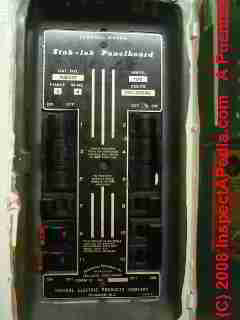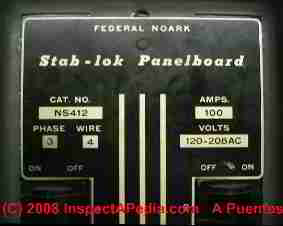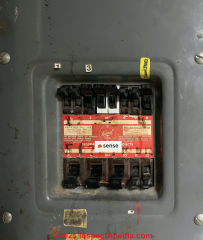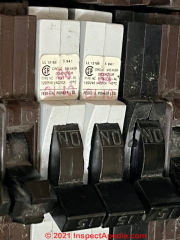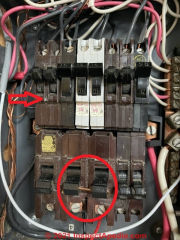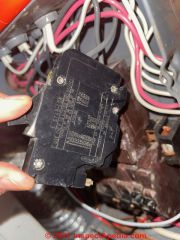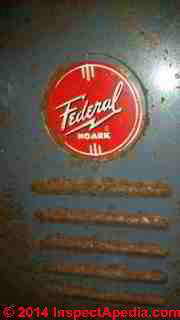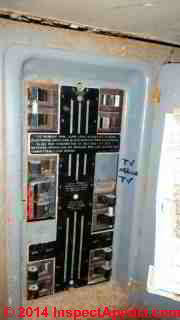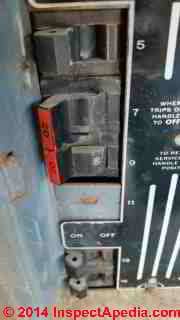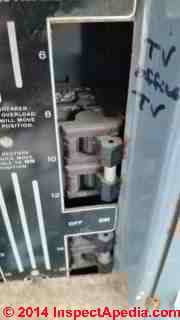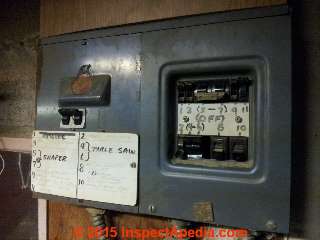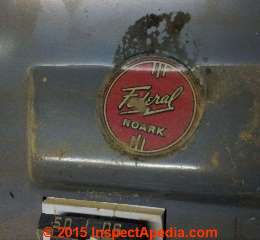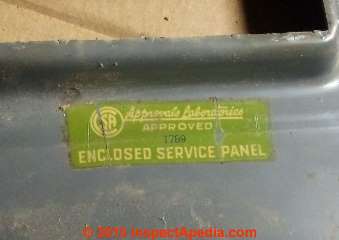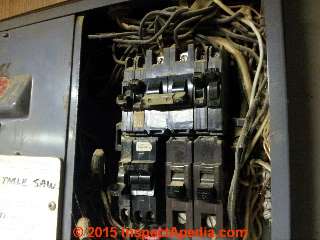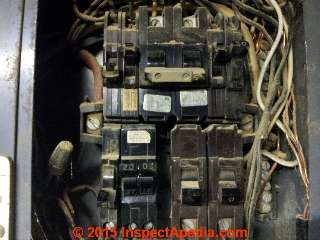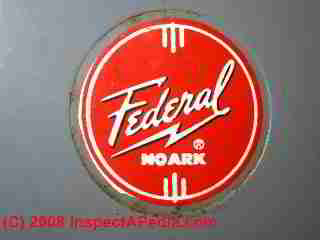 Federal NOARK Electrical Panels
Federal NOARK Electrical Panels
How to Identify Unsafe Federal NoArk Panels with Stab-Lok® design
- POST a QUESTION or COMMENT about Federal NoArk electric panels and circuit breakers
This document describes how to identify Federal Pacific Stab-Lok® Electric Panels in buildings with special focus on the Federal NOARK Stab-Lok® Panelboard and the Federal NOARK Load Center.
This is safety information for building inspectors, home buyers, home owners, electricians exploring the background of possible hazards associated with Federal Pacific Electric Stab-Lok® circuit breakers and service panels.
Replacement FPE Stab-Lok® circuit breakers are unlikely to reduce the failure risk of this equipment. We recommend that residential FPE Stab-Lok® electrical panels be replaced entirely or the entire panel bus assembly be replaced, regardless of FPE model number or FPE year of manufacture. We do not sell circuit breakers nor any other products.
InspectAPedia tolerates no conflicts of interest. We have no relationship with advertisers, products, or services discussed at this website.
- Daniel Friedman, Publisher/Editor/Author - See WHO ARE WE?
Photo Guide to Identification of Federal NOARK Electrical Panel Identification of Stab-Lok® Load Centers
[Click to enlarge any image]
Federal NoArk™ electrical panels (synonyms Federal NoArk, Federal NoArc, FPE No-Ark) or FPE no-arc electrical panel labels identify older versions of the Stab-Lok® circuit breaker design discussed beginning
at FEDERAL PACIFIC FPE HAZARDS
and summarized at FEDERAL PACIFIC FPE HAZARD SUMMARY.
You will see from the photos of various models and ages of Federal Noark electrical panels on this page that because FPE Stab-Lok design circuit breakers and panels were produced over many years and under a range of product names, nonetheless the details of imprinting or labeling of these electrical panels varied even while the brand, design, and name - in this case Federal Noark - remained constant.
Because the product design, materials, and history are all of a piece and share the same company, production, design,
Federal noark Stab-Lok panelboards and circuit breakers are of the same design and have the same hazards as other Stab-Lok ™electrical panel buses and circuit breakers.
Therefore this article focuses on how to identify Federal Noark panelboards. At left we show a Federal Noark Stab-Lok® Panelboard Model NS412.
The Federal Pacific Panel interior label and model number are shown in this photograph. [Photograph courtesy of Arlene Puentes.] Catalog No. 116-68C (Federal Pacific Electric Company) the FPE company name does not appear on this portion of the label.
- Photo guide to Federal NOARK (or Federal NOARC) load center identification shows the Stab-Lok® design identification
- Photographs of Federal No-Ark circuit breakers, labels, and bus designs provide means to identify this equipment even if labels are missing or painted-over
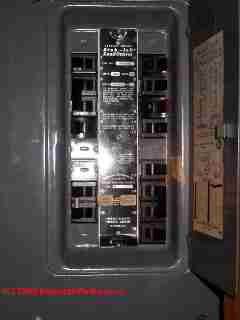
Here is what another model of the Federal NOARK Electrical Load Center looks like. (Some inspectors misreport this product as "Federal NOARC".)
Even before inspecting this electrical panel closely you can see the characteristic FPE Stab-Lok® circuit breaker red-painted toggle faces. The center black identification label in this Federal NOARC load center Catalog No. 116-68C is black painted.
Later FPE Stab-Lok® load centers painted white or other colored text directly onto the gray-painted electrical panel face.
Here is the unambiguous text which identifies this Federal NOARK load center as a Federal Pacific Stab-Lok® design and Federal NOARK Stab-Lok® LoadCenter Cat.No. 116-68C.
Note that in some literature the Federal Noark panelboard product may be referred to as "Federal Noarc" - typically a typographical error. Here are two more photographs to assist in identification of Federal NOARK electrical panels showing a Federal NOARK Stab-Lok® panelboard Cat.No. NS412.
...
GE / General Electric Federal NoArk Electrical Panels
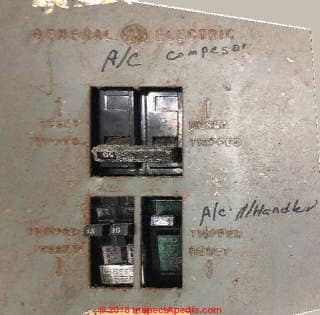 GE NoArk panel: these photos, contributed by an InspectApedia.com reader, identify a General Electric Federal NoArk 100A electrical panel.
GE NoArk panel: these photos, contributed by an InspectApedia.com reader, identify a General Electric Federal NoArk 100A electrical panel.
We don't know the age of the home nor panel but this GE NoArk is brand is consistent with the 1964 GE citation in our article FPE STAB-LOK HISTORY that includes GE among the ownership history of FP / FPE / Federal Noark electrical panels.
Question: An inspector asserted that this GE Federal Noark Electrical Panel OK - really?
While my understanding on Federal Pacific and Federal NoArk Stab-Lok electrical panels is that all or most panels are deficient or potential fire hazards I’m being told that this one is ok? - Brian M. Sweig - Fault Finders Inc., by private email 2018/08/26
Mr. Sweig is a professional working in Connecticut and New York. He informs us that at a follow-up consult he informed the property owner that this electrical panel suffers several safety hazards.
In this Q&A he discussed a report made by a home inspector who had asserted to the homeowner that there were no concerns with the electrical panel shown here.
Reply:
In my opinion nothing in what you were told was correct.
It's possible that the person telling you that the GE Federal NoArk panel in your photographs is "safe" was basing that statement on a report that the panel has not given any trouble over its long service life.
The fact that "no problem has been observed" in an old, unsafe electrical panel simply means that it continues to pass along current to the downstream devices. It's as if you're riding in a car with the seatbelt cut through to a single thread.
You think the seatbelt (circuit breakers that should trip in response to an overcurrent) is performing perfectly - because so far you've not been in a crash. But you do not have the safety protection you think you do.
It's also possible that the person telling you that a General Electric Federal NoArk electrical panel is "safe" thinks that the GE brand means the panel is of a different design and its breakers different from the problem-prone FP / Federal Noark circuit breaker and bus designs produced over many decades.
Four Safety Observations in this GE Brand Federal Noark Electrical Panel
 In my view that statement is a bit blind.
In my view that statement is a bit blind.
Even with the extremely-limited information of just two photos I can see that
- Corrosion:
the panel in your photo shows that panel cover is rusted (risking unreliable circuit breakers that may not trip in response to an over-current) - details about this hazard are
at CORROSION in ELECTRICAL PANELS - Loose faceplate:
the panel in your photo has a circuit breaker faceplate that is loose or the breakers are loose (gap and inset breakers, risking an arc explosion), as we see a large gap between the circuit breakers and the faceplate (see the photo above on this page). - FPE-Breaker design:
the label Federal NoArk confirms that the circuit breakers are of the FPE-design: a product that has a failure to trip rate as high as 80%, particularly on two-pole circuit breakers like the 50A breaker that in the Federal Noark panel photo is corroded.
I understand that someone might assume that the GE panel is using a different circuit breaker than the problematic FP-design but in my OPINION, if that were the case we would not see a Federal NoArk identifying label on the same panel enclosure. - Electrical Panel age:
Even without these visually-obvious unsafe conditions, a panel of this age should be the subject of a replacement recommendation by any home inspector or by any electrician familiar with electrical panel inspection and safety.
My language is a bit strong here, perhaps in response to my concern that incorrect advice, casually-given, perhaps at little or no cost or risk to the person giving it, puts the occupants and building where this panel is installed at serious risk of a shock, fire, injury or property loss.
Thanks for the photos. When you replace the panel - as you should - I'd like to see the conditions of its interior, bus, breakers, connections.
Watch out: regarding loose circuit breakers held into an FP or Federal Noark panel by its cover or faceplate: this electrical panel was not designed to rely on the cover to hold the circuit breakers securely in place.
Reliance on cover pressure on circuit breakers to keep the breaker seated is inherently dangerous, and in fact some time ago an electrician working in in the U.S. in Atlanta Georgia was killed from just this circumstance. On removing the electrical panel cover one or more circuit breakers moved, causing an electrical arc explosion and the worker died.
See FPE REPLACEMENT PANEL for more reader discussion of this electrical panel replacement options. We also discuss NoArk panel replacement in the NoArk panel FAQs - live link given below.
Is the the history and hazard of Federal Noark panels related to Federal Pacific Electric Stab-Lok Panels?
My electrical panel does not say "Federal Pacific," though it looks like the Federal Pacific panels. It says "Federal NoArk Stab lok panel". Is it safe? Thank you for your help. Best wishes, M.H. 7/8/2013
Reply: Federal Noark electrical panel bus and breaker designs are Stab-Lok products and obtain the same hazard warnings.
[The Federal Noark electrical panel and circuit breaker product line] has the same design and same hazards. Search InspectAPedia for Federal Noark and you should find our article on that name brand.
Reader follow-up:
Thank you, I searched InspectAPedia, but the only "article" I found was a series of pictures. It did not contain any information about the testing of Federal NoArk stab lok panels. It did not say what the years of manufacture were, nor did it say where these panels were made.
Were the Federal Pacific panels made in New Jersey? It seems incongruous to name a company on the east coast "Pacific".
Reply:
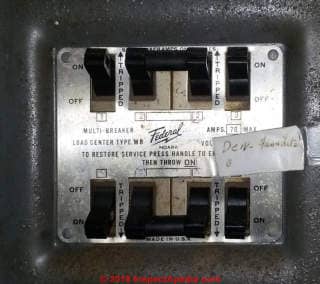 Thank you for this feedback. I will review that article with your comments in mind [and will make more clear that in referring to Federal NoArk Electrical panels we are talking about the same product design, materials, producing company, and hazards as are discussed under related names for this product line such as Federal Pacific Electric Stab-Lok.
Thank you for this feedback. I will review that article with your comments in mind [and will make more clear that in referring to Federal NoArk Electrical panels we are talking about the same product design, materials, producing company, and hazards as are discussed under related names for this product line such as Federal Pacific Electric Stab-Lok.
A rose by any other name would smell as sweet - Shakespeare, Romeo and Juliet.
Basically, (and presuming you were looking at FEDERAL NOARK PANELS) the key point is that the Federal Noark electrical panel and circuit breaker product is unambiguously and unequivocally the widely-discussed FPE Stab-Lok design, made by the same company and even generally the same people, using the same materials, with the same design flaws, the same hazards, but marketed under an earlier name, one of several synonyms for Federal Pacific Electric Stab-Lok circuit breakers and electrical panels that have been used over decades of production.
A look through FPE STAB-LOK HISTORY for the list of company names, dates, locations and history helps clarify that Federal Noark and Federal Electric and Federal Pacific Electric are the same product line and company. Or if you prefer to go directly to an example source document that ties these company names together see U.S. Patent No. 3,093,773.
Your question about the relationship between product name and factory location is an interesting one. The use of the word "Pacific" in Federal Pacific Electric does not relate to the geographic origin of those products and none were manufactured on the Pacific or west coast of the U.S. as you queried.
In fact the principal production facility was at Albemarle,
North Carolina. In 1952, Federal Electric Products Company, a U.S. company
that was later merged into FPE. FPE adopted the trademark "Stab-Lok® " .
The Federal Noark, Federal Electric, Federal Pacific Electric breaker design and panel bus design are unique in the electrical industry, and the rate of product failure stunning rates (as high as 60% fail to trip on an overcurrent, and 100% fail to trip on subsequent overcurrent events) in in industry where generally the failure of a circuit breaker to trip when it should occurs at a fraction of 1%.
A careful read of the Federal NOARK article and its illustrations shows that in fact a variety of "names" appear on the product line together, including
the key words "Stab Lok" (that do not appear on all the stab-lok products), also Federal Noark, Federal Electric Products Company (a predecessor name for Federal Pacific Electric), and Newark New Jersey. If you use the More Reading link near the page top you can find the complete collection of product history, testing, fraud charges, etc. that pertain.
Watch out: beware that there are other contemporary users of the name "Federal Pacific" such as a Federal Pacific company producing and selling electrical transformers. Searching for the history of Federal Noark or history of Federal Pacific names can thus be confusing.
There are also companies selling replacement breakers (that will fit in both your Federal NoArk panel and in Federal Pacific Electric panels) for which inspection and limited testing confirm no design changes from the original failing units. In fact some replacement FPE breakers are in fact "new old stock" purchased by an individual when the original company stopped production.
It would be prudent to recognize that swapping in these breakers is unlikely to reduce the FPE, FP, Federal Electric, or Federal Noark hazard one iota.
Lack of Testing of Federal Noark Equipment
The number of Federal Noark panels available for testing has been miniscule; but the history of their production, the company, the product, and its design are unambiguous.
The variety of names on the product line reflects the history of names used by the company producing the product, not differences in product design nor performance. Because the breaker performance problems are traced to the circuit breaker design, bus design, and a history of dishonest test procedures, product labeling violations, as well as actual field failures, there should be no question remaining about the product.
Sources of Disinformation & Misinformation about FPE Stab-Lok & related product names
Unfortunately, and quite transparently, out of a wish to avoid liability, there has also been a long history of counter-PR released from the company, its successors, and even today, its remains. That misinformation has been the chief source of confusion among consumers about the hazards of the product.
Equally unfortunately, at the time of the original CPSC testing of FPE Stab-Lok breakers, the company's lawyers avoided a product recall by using the incorrect argument that the unsafe conditions that caused breaker no-trips would not actually occur in the field).
That argument that convinced CPSC management to override the views its own engineers, and despite compelling and long-standing evidence of product testing fraud, product mislabeling, high product failure rates under independent testing, and product failures in the field, misinformation about the product safety remains in the public forum.
While FPE and its interests made much of the CPSC's dropping of its original investigation of the Stab-Lok product failure history, the CPSC never said that it found the product to be safe. The US CPSC, in an effort to correct the record and to warn consumers,
issued FPE INVESTIGATION CPSC Revised 2011.
Some of that disinformation was paid for by interested parties while other has arisen for other reasons. For example a PDF from homeinspectormark asserting that the panels are safe if the consumer avoids overloading them.
The publisher of that PDF file cloaks his own risky advice "talk with your electrician and decide what is right for you and your family" with data copied (without permission) from InspectaPedia.com.
Unfortunately most electricians are not familiar with FPE hazards, are accustomed to relying on electrical codes and government recalls as the sole source of product hazard information, and many make the further mistake of thinking that a visual inspection can determine that the installation is "safe" or worse, that in-situ testing should be performed (a step that can actually increase the risk of a subsequent failure of the breaker to trip).
Such advice is incorrect and can be dangerous. While we agree that it always makes sense to avoid overloading any electrical circuit, overcurrents and short circuits can still occur on any electrical circuit, even one into which nothing is plugged-in whatsoever! Should an overcurrent or short circuit occur on an electrical circuit, the consumer is relying on the circuit breaker to trip in time to prevent a fire.
Will avoiding an electrical circuit overload prevent an FPE Stab-Lok Failure and resulting fire?
NO. Avoiding an overload may reduce but will not eliminate risk on an inadequately protected electrical circuit.
Avoiding an FPE-failure and its concomitant risks of a building fire by advising the consumer to "avoid overloading the circuit" is therefore as incoherent as telling occupants in a car whose seat belts have been cut through to a mere single thread that the seatbelts are quite safe - as long as the vehicle avoids getting in an accident.
Such misinformation, or in some cases deliberate disinformation, arise from a melange of conflicting interests (avoid liability, or in the case of some home inspectors, please real estate agents who are a source of referrals) or perhaps in a few cases out of simple ignorance.
In sum, because the product about which you inquire is made by the same company, using the same design, and same materials, and because the product hazards accrue from the breaker and bus designs and materials, you can reliably assume that the no-trip hazards of the circuit breakers and the bus-burn-up hazards of the connecting bus in your Federal No-Ark panel is the same as its sister Federal Pacific Electric electrical panels in that product series.
If your home is served by a Federal No-Ark panel it should be replaced.
See FPE PANEL ADVICE for HOME BUYERS
Other articles in the "Related Links" section discuss panel replacement options, costs, and measures to minimize risk while waiting to replace the panel. But beware, even simple advice like "turn off the breakers to an electrical circuit that is acting strangely like causing flickering lights" is inadequate. An FPE-Stab-Lok design breaker may have its toggle switched to the "off" position but the breaker may remain "on" and thus the circuit "live".
We would much appreciate hearing any comments, critique, suggestions, or further questions that you may have after you've taken another look at this article as well as at the very long, documented, and well-tested information about the FP, FE, FPE, Federal Noark, product line.
Also, you are absolutely welcome to make PRINTED copies of any of our pages that you find useful, and to give them away to others where you find that useful. Our policy on use our website content, which does not permit people making online or electronic copies for the obvious reasons, can be read in more detail at COPYING
InspectAPedia is an independent publisher of building, environmental, and forensic inspection, diagnosis, and repair information provided free to the public - we have no business nor financial connection with any manufacturer or service provider discussed at our website.
We are dedicated to making our information as accurate, complete, useful, and unbiased as possible: we very much welcome critique, questions, or content suggestions for our web articles. Working together and exchanging information makes us better informed than any individual can be working alone.
Website content contributors whether it is just a small correction or an in-depth article series (which of course invites more search engine attention), are cited, quoted, and linked-to from the appropriate additional web pages and articles - which benefits us both.
A brief summary about InspectAPedia.com can be read at ABOUT
...
Reader Comments, Questions & Answers About The Article Above
Below you will find questions and answers previously posted on this page at its page bottom reader comment box.
Reader Q&A - also see RECOMMENDED ARTICLES & FAQs
Question: comment on this "Federal Pioneer" (Federal Noark) Electrical Panel in Toronto
I have [this] Federal Pioneer Sub panel installed in my home built in the 1960’s (Toronto, Canada). I’ve attached some photos below and I'm hoping you could look at them and comment on the safety of these breakers.
I’d greatly appreciate any insights you can offer! - Anonymous by private email 2021/5/09
Moderator reply: A dozen observations in your unsafe Federal Noark electrical panel
Thank you for the photos of your Federal NoArk electrical panel and its breakers and wiring. These will be helpful to other readers.
Watch out: bottom line: while we list a number of detailed safety observations for this electrical panel, ALL of them are moot in that the panel should be entirely replaced regardless, since it's a Stab-Lok design that is not reliable and therefore unsafe.
- This is a Federal Noark electrical panel, discussed on the page above] - it is an early generation of Stab-Lok electrical panel.
- Its circuit breakers are as unreliable as other Stab-Lok circuit breakers across the entire life of this design and across the various panel brands named in this series.
The worst FP performance and FPE performance is on double-pole breakers: 1 jams and then the other will not trip at ANY level of overcurrent. - No Main Switch: This FP panel has thirteen circuit breakers and no main switch
. It far exceeds the "rule of 6" so it would require either a main breaker in the panel, or a nearby, visible, and readily-accessible main switch, clearly-marked as MAIN, that would allow the homeowner or occupant to turn off the entire panel from one switch in event of an emergency. - Multiple breaker generations: see more than 1 generation of breaker; I see breakers that are identified as Federal Pacific Stab-Lok, Federal Pioneer, Federal Pacific Electric, Federal Noark:
that makes no difference in the breaker safety or performance; the no-trip hazards of this equipment have extended over the the product life and include production in the U.S., Canada, and also "replacement" breakers sold by third party vendor (and made offshore).
Beware of claims that replacement circuit breakers for this panel improve its safety. Independent testing shows that replacement breakers have about the same failure rates - far worse than the industry overall. - Watch out: I also see unsafe electrical practices like trying to bond two breakers on a 40A 240V circuit together using a bit of copper wire (circled in red) instead of a common and proper trip tie.
This detail is unsafe and worse, it is exactly the condition that invites a solid jam-up of a 240VAC Stab-Lok circuit breaker, resulting later in a no-trip at ANY level of over-current.
Watch out: Over-fusing: on clicking to enlarge the photo just above I also see that the wires connected to that 40A "double" pole FP circuit breakers look quite thin:
I suspect that's #14 wire this is rated for use on a 15A electrical circuit. Your wires are way over-fused - creating a fire hazard. - Corrosion risk in panel & breakers: In your photo my red arrow points to one of several white deposits that may indicate prior water leaks into the panel; if this is the case, corrosion inside of the breakers or at the breaker-to-bus connector increases the risk of an circuit breaker failure.
There is also rust in the panel bottom and on some of the connecting screws.
More detail is at CORROSION in ELECTRICAL PANELS - Over-Crowded electrical box: In this panel the original bus and breaker design accepted a total of eight full-width FP/FPE circuit breakers.
Your panel has thirteen circuit breakers installed. I would insist that the panel is likely to be over-crowded and perhaps over-taxed, though in the open-panel photo above we see that three breakers are no longer in use - there is no circuit wire connected to three of the bottom breakers. - Unreliable bus-connections: The panel uses mostly half-width circuit breakers; the breaker-to-bus connection is, in our OPINION and according to some of our FP field reports, less reliable than the full-width circuit breaker connection: adding more possible points of failure.
- Risk of mis-wiring 240V circuits: other readers have pointed out that when half-width breakers are installed in this panel it is possible to install a common-trip-tie breaker intended for 240VAC use such that both breakers are on the same 120V side of the panel.
The pair of white FP breakers at upper center appears to be a properly-connected 240V circuit -and though I can't say for certain it looks as if that pair of breakers are tied together (as they should be on a 240V circuit);
I can't say how the other circuits are used or wired. Above I warned about greater breaker jam hazards on 240V circuits in Stab-Lok panels. - Improper wiring at panel enclosure: an electrical inspector would also fail this installation on noting that wires enter the panel through over-sized knock-outs (upper left) with no strain relief; sparks are not kept in the panel and there is risk of a cut, damaged wire. I can't see enough but there may be more instances of this error.
- Physical damage: Perhaps less serious - no one can say from a photo - some of the breakers are physically damaged - chipped broken parts.
- We see copper panel parts and we see that all of your electrical wires are copper: copper is a better performer in electrical panels (in my OPINION) than plated steel.
General Comments on Federal Noark, Federal Pioneer, Federal Pacific Electric Stab-Lok Panel Breakers
 We've researched and worked with experts on FPE safety questions since 1986 so naturally there's plenty of information available.
We've researched and worked with experts on FPE safety questions since 1986 so naturally there's plenty of information available.
For a time the jury was out on the Canadian FP panels because we didn't have enough test data; was that because Canadian FP performed better? Ultimately the answer is no. But the population is smaller and the percent of Canadian readers at InspectApedia.com is smaller, both of which might explain, in part, why we had fewer FPE fire reports from Canada. (We estimate that in both countries less than 5% of electrical fires are ever reported through research and data analysis channels. So any reports take on an extra significance.)
In the past few years we've met that need and independent tests show that Canadian FP breakers fail to trip in response to an overcurrent at about the same rate as US equipment.
That's no surprise as it's the identical design, manufacturing methods, etc.
The hazard is a latent one: the panel doesn't in initiate a fire or failure, rather, when an overcurrent occurs, the breakers fail to protect you - up to 60% of the time, where in the industry in general the failure-to-trip rate is a tiny fraction - much less than 1%.
You cannot tell if FP (or FPE) breakers and panels are safe by visual inspection, though on inspection by removing breakers one might see bus damage from prior overheats; the root problem is inside the breaker - you can't see that. A breaker that looks fine and that "up to now has "worked" perfectly" by passing along current may simply not have been subjected to an overcurrent. In other words you won't see trouble until there is an overcurrent on the circuit.
Worse, fooling with these breakers is dangerous: simply flipping them on and off - we used to call that "exercising the breakers" and we thought it would help - actually has proven to increase the risk of a future no-trip! In-situ testing by applying overcurrent also increases the risk of a future no-trip as well as risking a fire in the building unless performed by an expert in this particular procedure. Don't do any of those things.
And of course I must add
Watch out: if you are not familiar with safe and proper electrical practices, just removing the cover of an electrical panel is dangerous, and touching a live connection inside can shock or kill you.
You will want to start at the topic home page
FEDERAL PACIFIC FPE HAZARDS at InspectApedia.com - online encyclopedia of building & environmental inspection, testing, diagnosis, repair, & problem prevention advice.
Or in the
ARTICLE INDEX to FPE STAB-LOK BREAKERS & PANELS
You'll find details about Canadian FP breakers, research and failure testing reports, and if you're strapped and can't afford to immediately replace your panel (which is the recommended course of action) there is an article on how to reduce risks if you can't afford a replacement panel.
I particularly recommend
FEDERAL PACIFIC FPE HAZARDS - home
FEDERAL PIONEER PANEL SAFETY
CAN'T AFFORD A NEW ELECTRIC PANEL?
FPE Stab-Lok® : FIRES WAITING TO HAPPEN
Please take a look at that material, replace your panel as soon as you can, meanwhile remain alert for trouble signs (see the "can't afford...." article), and don't hesitate to let me know if any of the material you find is unclear or leaves you with questions. Working together makes us smarter.
FPE and FP are not the only poor-performing panels but they're in a comparatively smaller and special group as you'll see in some of the test reports where multiple brands were examined.
Reader Question: are Federal NoArc Panels in California - part of the Stab-Loc family?
11/11/2014 Federal NoArc electric box said:
We have a federal noarc electric box in our house we just moved into (built in 1953). Is it of the Stab-loc family of no trip breakers? We live in Los Angeles County. Do we need to replace our panel? Attached are photos of it our Federal NoArk electrical panel box, cover, label, and circuit breakers.
Everything is working fine but we wanted to hook up a 60 amp GFCI sub panel for our spa it and it doesn't really look possible. Thanks, - J.S., LA CA 11/2014
Reply:
Yes Jason, the FPE Stab-Lok design with the safety issues discussed in this article series were produced over quite a few years and sold under more than one brand mark, including the Federal Noarc. Thanks for the photos - I'll post them in the article above and comment further.
Watch out: in addition to the unreliability (failure to trip on overcurrent) of these circuit breakers, your photos show rust on the panel raising additional safety and no-trip worries independent of the FPE concerns.
See CORROSION in ELECTRICAL PANELS
Your photos also show missing breakers and open electrical panel cover slots - the photo at below right - an unsafe condition as sparks can easily exit the panel, risking a fire in in nearby combustibles.
You should replace the panel.
Reader Comment: Field Report: Federal Noark Electrical Panels in Windsor Ontario, Canada
I was reading in many sources, particularly home inspectors' discussion boards, about other issues when I stumbled upon a photo of a breaker panel and some mention about why Stab-Lok breakers are so bad - as is the nature of researching on the internet my focus shifted to that for a while.
I recalled rather clearly that the apartment I grew up in had a Stab-Lok panel which advertised that name very obviously on it. I further recall a situation where a damaged TV cord that shorted neutral to hot did not trip the breaker despite causing quite a bit of smoke.
[Click to enlarge any image]
I bought my first house a year ago, had a home inspector who is well-reviewed go over it, and he found no issues with the electrical system but cautioned that he isn't an electrician.
There is a detached garage with electricity. The main panel in the house is a Novaline which is quite old but I'm told they're considered to be good panels.
The garage sub panel is a Federal Noark. Since the breakers externally look like the Stab-Lok breakers (unique shape of the lever) I decided to pop open the cover and see.
I do not know the age of the garage and its wiring (where the Federal panel resides), however the house was built in the 1940s. The garage has been added onto multiple times.
I believe electricity was brought into the garage in the 70s or early 80s. The wiring in the garage is a mixture of types - plastic jacket with ground, and cloth jacket with or without a ground in various spots, as well as what you can see in the pictures which is in metal conduit.
The garage has a couple of 240 outlets (the small twist style, not big like a dryer outlet) in addition to easily a dozen 120s.
One of the breakers is very wobbly...as if next to nothing is holding it in. This doesn't inspire confidence. I operate power tools on these circuits, and unattended things like battery chargers. I need to be able to trust this panel.
About the loose breaker...the panel cover actually is applying a fair amount of pressure on the breakers themselves.
Does this in any way improve the reliability of the connection to the buss bar?
I understand the breakers are flawed at a design level, but if I can rest assured that the panel won't go up in flames at any random time...only connect loads when I am present, etc, it would help since even a small panel is not cheap to replace and will be something to save up for.
I already know from what I've read that your advice, and that of others, will be to replace this panel. I figured you may want the photos, so I've attached them.
K.K. in Canada - by private email, 2015/12/28
Reply:
Thank you for the additional Federal Noark panel photos, we include them in this article as an aid to other readers. Indeed these are an FPE Stab-Lok design electrical panel and circuit breakers that was widely distributed in both the U.S., and as your email indicates, in Canada as well.
Your photos show that in addition to the questionable performance of this product - failures of the circuit breaker to trip in response to overcurrent and poor breaker connections in the panel - this panel is quite over-crowded.
In my opinion the home inspector should have warned you about the performance history of the Federal Noark panel in your home.
However some home inspectors, in my experience now a small minority, are of the view that their job is easier, faster, and less contentious if they eschew reporting of hazardous products for which there is not a widely-known government-demanded product recall.
...
Continue reading at FPE HAZARD SUMMARY or select a topic from the closely-related articles below, or see the complete ARTICLE INDEX.
Or see FEDERAL NOARK PANEL FAQs - questions & answers about Federal NoArk panels posted originally on this page.
Or see these
Recommended Articles
- FPE & FP IDENTIFICATION, HOW TO
- FPE HAZARD REPORT - 2017 [PDF] independent research article by Jess Aronstein, supercedes older FPE hazard reports by this author - separate file reports independent FPE failure test results
- FPE HAZARD SUMMARY
Suggested citation for this web page
FEDERAL NOARK PANELS at InspectApedia.com - online encyclopedia of building & environmental inspection, testing, diagnosis, repair, & problem prevention advice.
Or see this
INDEX to RELATED ARTICLES: ARTICLE INDEX to FPE STAB-LOK BREAKERS & PANELS
Or use the SEARCH BOX found below to Ask a Question or Search InspectApedia
Ask a Question or Search InspectApedia
Try the search box just below, or if you prefer, post a question or comment in the Comments box below and we will respond promptly.
Search the InspectApedia website
Note: appearance of your Comment below may be delayed: if your comment contains an image, photograph, web link, or text that looks to the software as if it might be a web link, your posting will appear after it has been approved by a moderator. Apologies for the delay.
Only one image can be added per comment but you can post as many comments, and therefore images, as you like.
You will not receive a notification when a response to your question has been posted.
Please bookmark this page to make it easy for you to check back for our response.
IF above you see "Comment Form is loading comments..." then COMMENT BOX - countable.ca / bawkbox.com IS NOT WORKING.
In any case you are welcome to send an email directly to us at InspectApedia.com at editor@inspectApedia.com
We'll reply to you directly. Please help us help you by noting, in your email, the URL of the InspectApedia page where you wanted to comment.
Citations & References
In addition to any citations in the article above, a full list is available on request.
- Timothy Hemm, Yucala, CA, contributed the photographs of FPE equipment installed in California buildings. Mr. Hemm can be contacted at TimHemm@yahoo.com
- Arlene Puentes [Website: www.octoberhome.com ] , an ASHI home inspector in Kingston, NY, contributed the page top and example photograph of a bank of FPE adjacent electrical panels and the Stab-Lok® NOARK panelboard photos just above. Ms. Puentes can be contacted at ap@octoberhome.com
- Jon Bolton, a home inspector, the Inspectigator, FL, contributed the "camouflage" breaker. Mr. Bolton can be contacted at teamattitude@hotmail.com
- Mary DeMuth, a property owner, contributed the Texas Federal Pacific Electric Load Center photos, May 2006.
- Thomas M. Pino, a professional home inspector, contributed photos of the 100A Texas FPE panel used in a condo. www.sweetwaterhomeinspection.com. Mr. Pino can be contacted at sweetinspect@houston.rr.com or at sweetwaterhomeinspection@yahoo.com
- The remaining photographs on these pages were made by the web author.
- The Federal Pacific Stab-Lok® Electric Panel Hazard Website Safety Information for Consumers.
- 2007 FPE Stab-Lok® TECHNICAL REPORT - an updated test report of independent testing (a large 1.2MB PDF file) using a larger pool of FPE Stab-Lok® circuit breakers than the older CPSC and Wright Malta tests found significantly higher failure rates of FPE Stab-Lok® circuit breakers, including a look at critical safety failures (breaker failed to trip at 200% of rated current or jammed) which found up to 80% failure rate for FPE Stab-Lok® GFCI circuit breakers (n=4), 12% failure rate for double pole FPE Stab-Lok® circuit breakers (n=120), and a 1% failure rate for FPE Stab-Lok® single pole circuit breakers (n=345).
- SAFETY for ELECTRICAL INSPECTORS for Electrical and Home Inspectors at Residential Electric Panels
- In addition to citations & references found in this article, see the research citations given at the end of the related articles found at our suggested
CONTINUE READING or RECOMMENDED ARTICLES.
- Carson, Dunlop & Associates Ltd., 120 Carlton Street Suite 407, Toronto ON M5A 4K2. Tel: (416) 964-9415 1-800-268-7070 Email: info@carsondunlop.com. Alan Carson is a past president of ASHI, the American Society of Home Inspectors.
Thanks to Alan Carson and Bob Dunlop, for permission for InspectAPedia to use text excerpts from The HOME REFERENCE BOOK - the Encyclopedia of Homes and to use illustrations from The ILLUSTRATED HOME .
Carson Dunlop Associates provides extensive home inspection education and report writing material. In gratitude we provide links to tsome Carson Dunlop Associates products and services.


